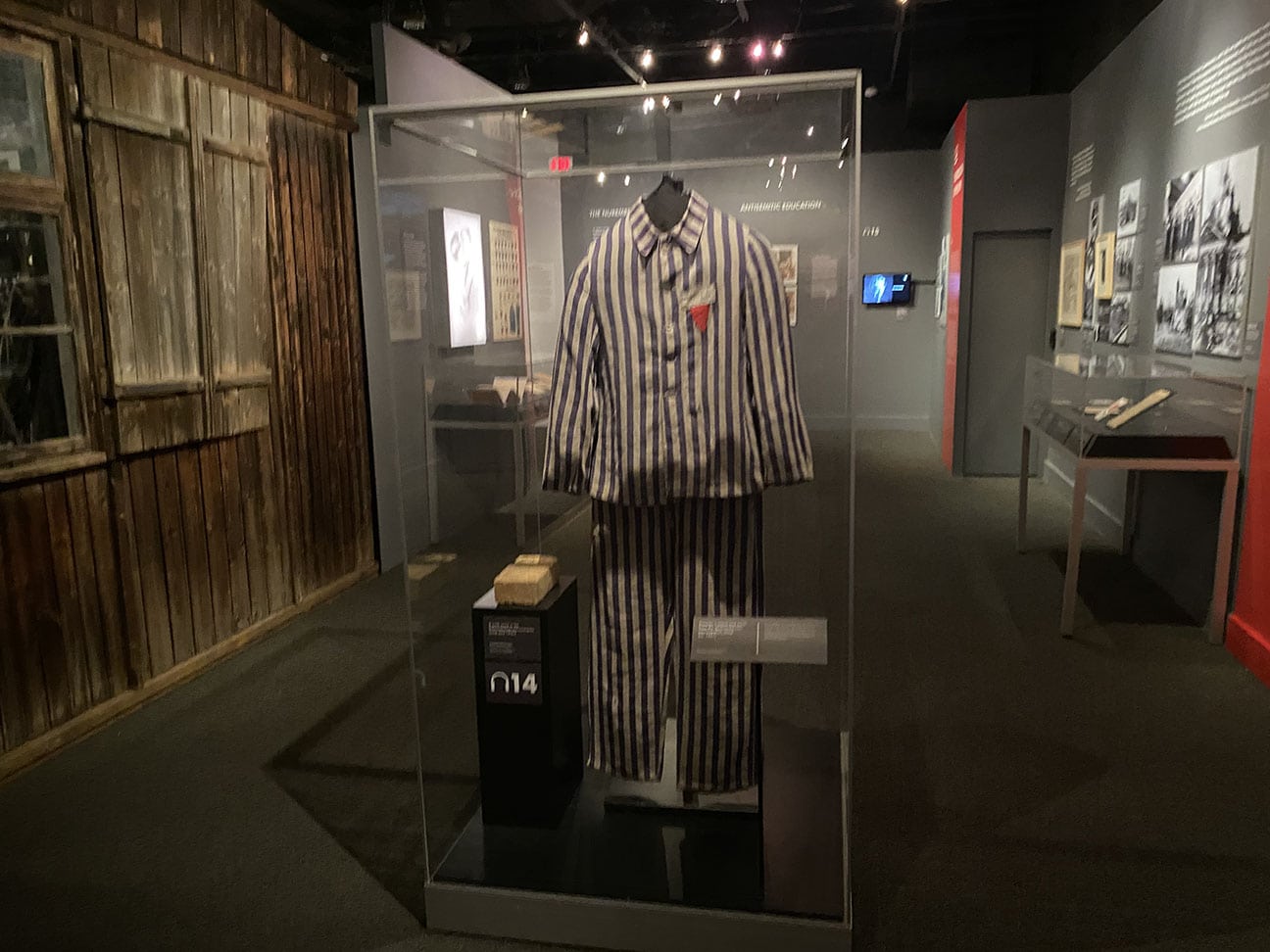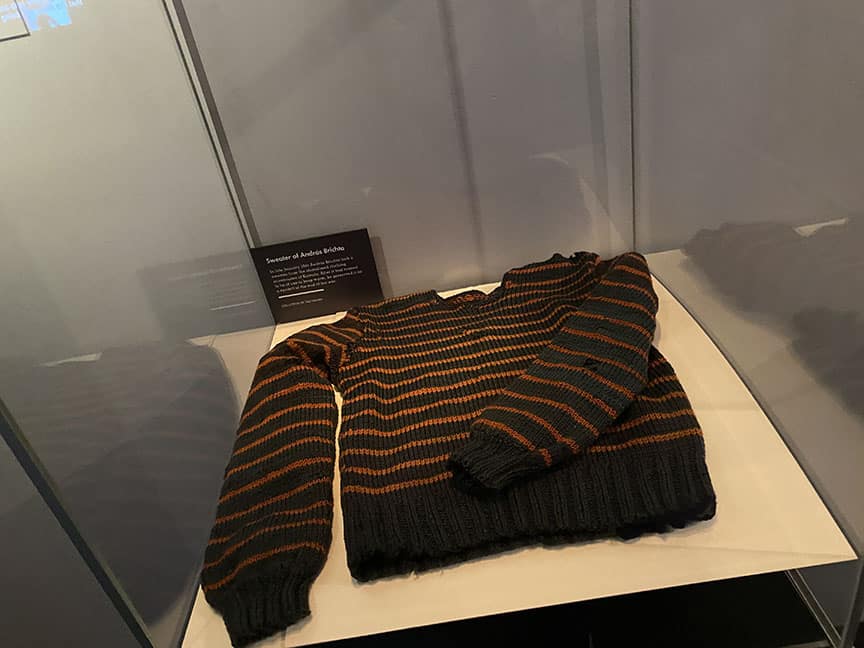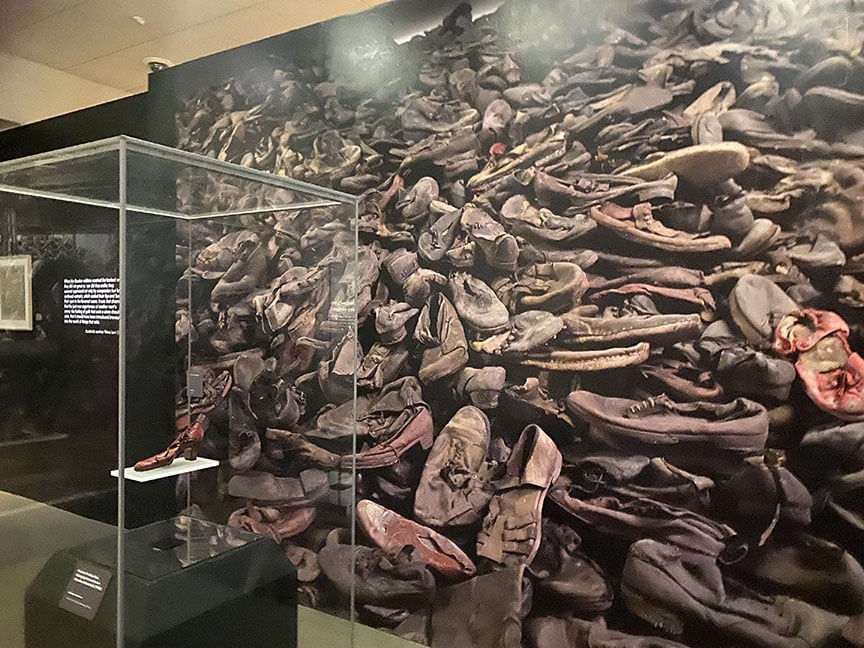 Photo by Aaron Bandler
Photo by Aaron Bandler For the next 10 months, the Ronald Reagan Foundation and Presidential Institute in Simi Valley will be featuring an Auschwitz exhibit that takes attendees through not only the history of the Nazi death camp but also antisemitism itself.
The exhibition, titled “Auschwitz. Not long ago. Not far away.” is formed by the Spanish company Musealia in conjunction with the Auschwitz-Birkenau State Museum (ABSM) in Poland, and features more than 700 artifacts and 400 photographs from Auschwitz. Among the artifacts are possessions from prisoners including shoes, glasses, hangers, cigarettes (used as currency among the prisoners), tools and a sweater worn by a Holocaust survivor.

“It’s a very, very impactful exhibit and it’s really designed to educate people of a certain age that don’t have any direct connection, relative, friend what have you to what happened during the Holocaust,” Ambassador Gordan D. Sondland, Presenting Underwriter of the exhibit and the son of Holocaust survivors, told the Journal. “And it’s also a little bit of a slap in the face, hopefully, to Holocaust deniers.”
“These objects, these possessions came from real people that had real lives and what knocks me over is that just about anything you will see under glass here that someone once prized as a heirloom, as a possession, as a simple article of clothing, it’s what helped to represent their humanity,” Ronald Reagan Presidential Foundation and Institute Executive Director John Heubusch said.
Piotr Cywinski, ABSM Director, told the Journal that the authenticity of the artifacts and photographs provides a “unique experience” for those who are unable to travel to Auschwitz itself. Cywinski also pointed out that the exhibit features some items from the Nazis as well that were used in the camp, including a gas mask and SS boots. “It’s really a very complex history that is told,” Cywinsi said. “It’s complex not only from the point of view of the complexity of the history but of the emotions that you can feel when you go through the exhibit.”

The exhibit begins with a model of the death camp’s fence and some statistics about the civilians murdered at Auschwitz. But before the Nazis used the town as a death camp, the exhibit explains that Auschwitz was simply a “small town” in Poland bordering Austria-Hungary and Germany.
Attendees are then taken on a journey through a brief history of the Jewish people and then of modern antisemitism. The exhibit explains that “19th century Christian anti-Judaism merged with a new idea: racial theory.” Antisemites promulgated this theory to argue that Jews were racially inferior and thus “a threat” to Western civilization that couldn’t be saved through conversion or assimilation. Jew-hatred increased in post-World War I Germany as blood libels spread “that Jews either shirked military service or were successful in finding jobs in military offices.” “A statistical investigation undertaken by the army clearly demonstrated that this accusation was unfounded, but that did not have any effect on public perception,” the exhibit states. When the Nazis rose to power in Germany, they brought antisemitism into the country’s schools, teaching students that Jews were “lecherous” and “non-patriotic capitalists,” among other things.

“We felt with this exhibit, as we do with all of our exhibits, that it’s important to set the stage and provide context for the events that you will see when you go through the exhibit,” Heubusch told the Journal.
As for Auschwitz itself, attendees will learn that historians debate on whether or not the death camp was initially designed to house Soviet prisoners or if it was “ad hoc” before it became a death camp. Artifacts and the the aftermath of World War II are also explored.
“The big question is what to do with the remembrance today,” Cywinski said. “This is the kind of thought we wanted to wake up in our visitors: what it means to me today to remember.” Cywinski added that “it’s so strange that 80 years after the war” that there are still voices demonizing the Jews and Israel. “That means really we have to think, what is the role and place of our remembrance today?” Cywinski said.
Sondland said that what ultimately led to the Holocaust was that “ordinary people” in Germany were “sold a pack of lies and believed them, and this is happening today everywhere on other subjects.” He added that the exhibit is “a call to vigilance as well.”

Heubusch said that Reagan spoke many times “about the horrors of the Holocaust as a way to remind the American people of what really truly did occur and to help give them a sense of how it’s a piece of history that we should never repeat,” adding that spreading this message was “so important to him.” “If there’s one thing that was important to him, it was human rights,” Heubusch said of Reagan. “And this is the ultimate destruction of human rights and when you go through this museum you will see it.” Heubusch also said: “With a hugely unfortunate rise in antisemitism that seems to be occurring not only in the United States but around the world, this [exhibit] is a really important present-day reminder of where that ugliness can go and why it should never happen again.”






















 More news and opinions than at a Shabbat dinner, right in your inbox.
More news and opinions than at a Shabbat dinner, right in your inbox.